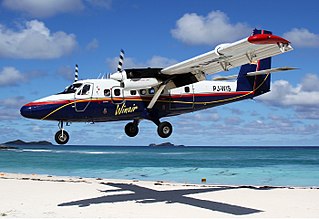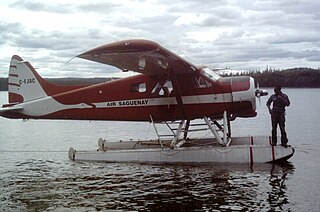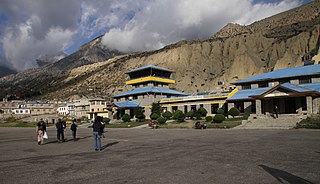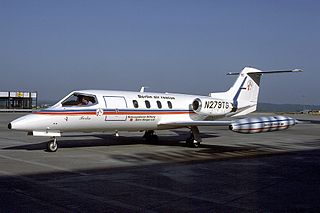
The de Havilland Canada DHC-6 Twin Otter is a Canadian STOL utility aircraft developed by de Havilland Canada in the mid-1960s and still in production today. De Havilland Canada produced it from 1965 to 1988; Viking Air purchased the type certificate, then restarted production in 2008 before re-adopting the DHC name in 2022. In 2023 DHC restarted production of the 300 series, in addition to the Series 400 produced by Viking. The aircraft's fixed tricycle undercarriage, STOL capabilities, twin turboprop engines and high rate of climb have made it a successful commuter airliner, typically seating 18–20 passengers, as well as a cargo and medical evacuation aircraft. In addition, the Twin Otter has been popular with commercial skydiving operations, and is used by the United States Army Parachute Team and the 98th Flying Training Squadron of the United States Air Force.

The de Havilland Canada DHC-3 Otter is a single-engined, high-wing, propeller-driven, short take-off and landing (STOL) aircraft developed by de Havilland Canada. It was conceived to be capable of performing the same roles as the earlier and highly successful Beaver, including as a bush plane, but is overall a larger aircraft.

Harbour Air Seaplanes is a scheduled floatplane service, tour and charter airline based in Richmond, British Columbia, Canada. The predominantly seaplane airline specializes in routes between Vancouver, Nanaimo, Victoria, Sechelt, Comox, Whistler and the Gulf Islands, primarily with de Havilland Canada floatplanes. Harbour Air operates de Havilland Beavers, Otters and Twin Otters.

West Coast Air was a Canadian scheduled airline operating de Havilland Canada DHC-6 Twin Otter float planes, which was integrated into Harbour Air Seaplanes.

Kenn Borek Air is an airline based in Calgary, Alberta, Canada. It operates regional passenger and cargo services, contract operations in the Arctic and Antarctic and aircraft leasing. Its main base is at Calgary International Airport. It charters aircraft for scientific expeditions, oil exploration, etc., and operates air ambulance services.

Kenmore Air Harbor, Inc., doing business as Kenmore Air, is an American airline with its headquarters on the grounds of Kenmore Air Harbor in Kenmore, Washington, United States, north of Seattle. It operates scheduled and charter seaplane and landplane service to destinations throughout western Washington and southwestern British Columbia, as well as seaplane "flightseeing" flights around Seattle. In addition to its corporate headquarters, seaplane maintenance facility and terminal in Kenmore, the airline has hub operations for seaplanes at its terminal on Seattle's Lake Union and for land planes at Seattle's Boeing Field/King County International Airport. It also operates a maintenance facility for its landplane fleet at Boeing Field.

Air Saguenay was a regional airline based in Jonquière, Quebec, Canada.

Continental Express Flight 2574 was a scheduled domestic passenger airline flight operated by Britt Airways from Laredo International Airport in Laredo, Texas to Houston Intercontinental Airport (IAH) in Houston, Texas. On September 11, 1991, the Embraer EMB 120 Brasilia turboprop, registered N33701, crashed while initiating its landing sequence, killing all 14 people on board. The aircraft wreckage hit an area near Eagle Lake, Texas, approximately 65 miles (105 km) west-southwest of the airport.

Jomsom Airport is a domestic airport located in Jomsom serving Mustang District, a district in Gandaki Province in Nepal. It serves as the gateway to Mustang District that includes Jomsom, Kagbeni, Tangbe, and Lo Manthang, and Muktinath temple, which is a popular pilgrimage for Nepalis and Indian pilgrims.

Air Moorea Flight 1121 was a de Havilland Canada DHC-6 Twin Otter which crashed into the ocean shortly after takeoff from Moorea Airport on Moorea Island in French Polynesia on 9 August 2007, killing all 20 people on board.
Taquan Air is the operating name for Venture Travel, LLC, an American regional airline headquartered in Ketchikan, a city in the southeastern portion of the U.S. state of Alaska. It operates domestic scheduled passenger and charter services. Its base is Ketchikan Harbor Seaplane Base, which shares the same harbor and airspace as Ketchikan International Airport. As per the United States Department of Transportation in a report dated August 2, 2010, Taquan Air is a "U.S. Certificated Air Carrier", and is 1 of 125 such carriers in the US.

Yeti Airlines Flight 101 was a domestic flight in Nepal, that crashed on final approach to Tenzing-Hillary Airport in the town of Lukla in eastern Nepal on 8 October 2008. The De Havilland Canada DHC-6 Twin Otter Series 300 registered as 9N-AFE originated from Tribhuvan International Airport in Kathmandu.

On August 9, 2010, a privately operated amphibious floatplane crashed near Aleknagik, Alaska, killing five of the nine people on board. The fatalities included former U.S. Senator Ted Stevens, while the survivors included former Administrator of NASA and then-CEO of EADS North America Sean O'Keefe, his son, and future Deputy Administrator of NASA James Morhard.

On 9 December 2012, a Learjet 25 business jet carrying five passengers including American singer Jenni Rivera crashed south of Monterrey, Mexico, minutes after taking off from the city's international airport. All aboard, including two crew members, were killed.

Downeast Airlines Flight 46 was a scheduled airline service in the United States from Boston's Logan International Airport to Rockland, Maine operated by Downeast Airlines. On May 30, 1979 a de Havilland Canada DHC-6 Twin Otter operating the flight crashed during a nonprecision approach to Rockland's Knox County Regional Airport. All but one of the 18 people on board were killed. The cause of the accident was controlled flight into terrain (CFIT) after the failure of the flight crew to stop the aircraft's descent below the minimum descent altitude for the non-precision approach at Knox County airport. The investigation into the accident looked into the airline's corporate culture as a contributing factor to the crash; this was the first time an investigation took this approach to an air crash.

On 27 July 2000, de Havilland Canada DHC-6 Twin Otter operated by Royal Nepal Airlines crashed in Nepal en route from Bajhang Airport to Dhangadhi Airport on a domestic passenger flight. The wreckage of the aircraft, registration 9N-ABP, was found in Jogbuda, Dadeldhura District. All 22 passengers and the three crew aboard were killed in the crash. An investigation into the crash was launched by Nepalese authorities after the accident site was located.

On 31 December 2017 at about 3:15 pm AEDT (UTC+11:00), a de Havilland Canada DHC-2 Beaver configured as a floatplane crashed into Jerusalem Bay off Cowan Creek, on the northern outskirts of Sydney, Australia. The aircraft, operated by Sydney Seaplanes, was carrying five passengers and a pilot, all of whom were killed in the crash. It was returning diners from Cottage Point Inn restaurant to Rose Bay Water Airport. The ATSB believes it probable that the pilot's performance was adversely affected by carbon monoxide poisoning. Post mortem tests on the bodies of the victims showed raised levels of CO in the blood, and a crack in the exhaust system was seen as the likely source of the gas.

On 4 August 2018, a de Havilland Canada DHC-2 Beaver aircraft operated by K2 Aviation crashed in poor weather near Denali, Alaska, United States. All five people on board survived the crash, but died before rescuers were able to arrive at the scene. The five people consisted of the pilot and four Polish tourists.

Taquan Air Flight 20 was a regularly scheduled commuter flight operated by Taquan Air from Ketchikan Harbor Seaplane Base to Metlakatla Seaplane Base. On May 20, 2019, the pilot lost control of the de Havilland Canada DHC-2 Beaver floatplane while landing in the harbor at Metlakatla, Alaska, United States. The airplane overturned, destroying the aircraft and killing both persons aboard. The accident was attributed to challenging wind conditions that proved too difficult for the relatively inexperienced pilot to handle.

On May 13, 2019, a de Havilland Canada DHC-2 Beaver floatplane operated by Mountain Air Service collided with a Taquan Air de Havilland Canada DHC-3 Turbine Otter floatplane over George Inlet, Alaska, United States. The DHC-2 broke up in mid-air with the loss of all four passengers and the pilot. The DHC-3 pilot was able to maintain partial control, but the aircraft sustained substantial damage in the collision and the subsequent forced landing; the pilot suffered minor injuries, nine passengers suffered serious injuries, and one passenger was killed. Both aircraft were conducting sightseeing flights under visual flight rules, which state that the pilot of each aircraft is responsible for visually ensuring adequate separation from other air traffic, commonly known as "see and avoid".




















